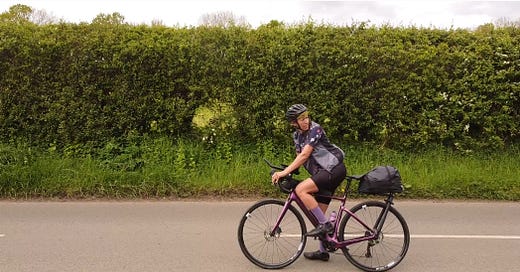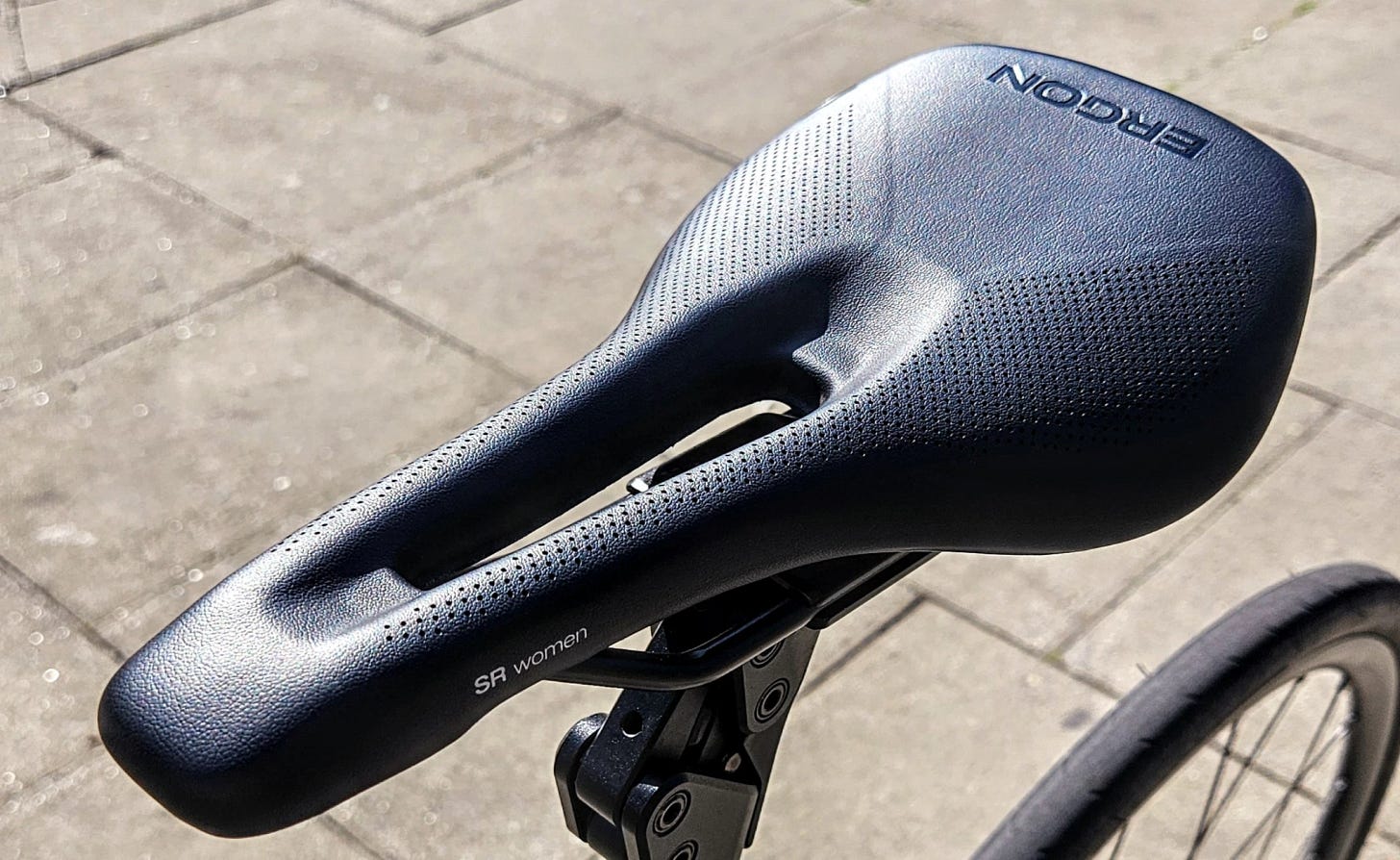It’s only a few short weeks until I take on my biggest adventure to date: an eight-country bikepacking race that starts in Italy, passes through Austria, Germany, Czech Republic, Denmark, Sweden, Finland, and finishes 4,136km later at North Cape in Northern Norway.
It’s by far the biggest challenge I’ve ever set myself and I know it’s going to be a battle of so much more than just the physical – in fact, I’d even argue that riding my bike is probably going to be the easiest part. Navigating the emotional highs and lows that come with cumulative fatigue, extreme sleep deprivation, and traversing languages and cultures is going to be the true test.
Saying that, I can’t ignore the fact that riding my bike for 14 hours a day for 2+ weeks is going to place a monumental amount of strain on my body, and my priority is ensuring I can complete the race as safely – and comfortably – as possible.
That’s why I decided to go and see Niel Copeland at Butternut Bikes in Crouch End, London. Niel is a seasoned ultra distance cyclist, having completed over 15 endurance events, including Race Around Rwanda, Atlas Mount Race, and the infamous Transcontinental. When he’s not out racing or riding he can be found imparting his wealth of experience as an endurance cycling coach and – luckily for me – bike fitter!
Now, let’s be clear, this is not my first rodeo; I’ve had bike fits before (which I touch upon in a previous article), but I’ve always felt like a bit of a lost cause. The girl who rides insane distances and wants it to be comfortable. Ridiculous. But then along comes Niel – a man who’s seen and ridden it all – and assures me that he can help.
This weekend I managed to get outside, enjoy the (exceptionally delayed) summer weather, and test out the changes. So, what’s the verdict?
Shoes
First things first, I’d like to make it known that shoes were not at all on my radar of things that needing changing. I count myself lucky that I’ve never had anything too dramatic happen to my feet whilst out on a ride, bar the odd numb big toe after particularly monstrous efforts. Well guess what? It turns out numb big toes are not normal, nor something that need to be ‘endured’ if you’re in the ultra game (or any game, for that matter).
Niel started by measuring the toe box of my shoe in comparison to the width of my actual foot. Oh dear. It was startlingly obvious that my toes were having to scrunch themselves into the limited space I had gifted them; a position that saw the big toe in particular pushing itself into the side wall, desperate to escape “Ah, well that’s probably not good”.
As it turns out, cycling shoes are supposed to fit a lot looser than I had originally thought. Much like running trainers, you need to give your feet room to swell when they get hot – something that tends to happen when you use them to propel yourself monumental distances. “A finger should fit loosely behind the heel” Niel told me, as mine turned white with the effort.
Once I slipped on the recommended pair of shoes it was like a lightbulb went off: “Is this what they’re supposed to feel like?”
Aside from upgrading my toes from a studio apartment to a generous suburban duplexe, space wasn’t the only issue. Stability is also a critical factor when it comes to repetitive motion over long distances; your body gets tired, and when it gets tired it gets lazy. Unfortunately, lazy will eventually result in every athlete’s worst nightmare: the dreaded niggle. The more we can help to support our body (through a mixture of neat kit and strength work), the more we can enjoy time in the saddle sans injury.
So not only am I now the proud (but unsuspecting) owner of a new pair of Lakes, I also purchased a pair of carbon innersoles from Amazon to help keep things turning efficiently when I’m 2,000km deep into my event.
Once out on the road I could feel the difference immediately; my feet felt, well, supported. Looking down, my right ankle was no longer collapsing into my crank, and everything just felt “right”. I could even wiggle my big toe as it sprawled itself across the floor of its new residence.
Big tick.
Handlebars
Here’s a fun fact. Almost all bikes are installed with handlebars that are too wide for the average woman. Not hugely shocking when you consider the dominant demographic of the sport, but a very reliable way to convince women that cycling is not “made for us”.
Your handlebars are supposed to match the width of your loosely outstretched arms when standing in a neutral position. If you compare that to what’s currently on your bike, I’m going to go out on a limb (wahey!) and guess that your bars force your arms outwards into a slightly unnatural position. The result of this tends to be flared elbows, which push the shoulder blades forward, creating tension across the lower back and through the neck.
In order to create a more neutral position, I had narrower bars installed and the shifters flared inwards to allow my hands to rest more comfortably without putting pressure into the wrist – another common issue.
On the road this was probably the biggest game-changer of all. Not only did my entire upper-body feel more relaxed, but I also felt more in control of the bike; my hands carried far less of my weight and I no longer felt the need to rotate my neck to alleviate the tension.
For even more comfort, I also installed Redshift’s drop bar grips to help prevent some of the nerve issues I’ve suffered in the past. These, alongside my aerobars, give me numerous hand positions I can adopt over longer distances to distribute pressure. That, and they’re damn comfy!
Massive tick.
Saddle
The part you’ve all been waiting for. And yes, I did buy yet another saddle. But hear me out.
In the past I’ve blindly picked and tried saddles based purely on the reviews of others. It sounds silly reading it back, but genuine research and education on what women need in a saddle is few and far between. This article has been the best thing I’ve read in a long, long time and I bet I’m not the only one who experienced a few ‘a-ha’ moments as I studied the paragraphs.
One of my biggest takeaways was the importance of language and giving women a voice. All too often we talk about ‘saddle sores’ because we’re too embarrassed, prude, or ashamed to point at or name the part that really hurts. ‘Saddle sores’ is such a generic term that can be interpreted in so many different ways by so many different people; no wonder we’re not getting to the route of the problem.
Something I truly respected about Niel was his openness to discussing female anatomy and creating a safe space to be more explicit about where I was suffering the most.
Based on that information, he was then able to advise a change in saddle – but this time, with clear rationale for why this one in particular would help.
You see, my old saddle was a similar width, but the ‘wings’ curved slightly downwards. To my untrained eye this “looked comfortable”, but reality was telling me something very different.
Niel explained that the curved wings meant that my sit-bones were positioned slightly lower, resulting in more pressure towards the middle of the saddle on my soft tissue. Now that he said this out loud, it made a lot of sense.
Cue the Ergon. Instead of curved wings, the platform is much flatter. This means that my sit-bones perch a little higher, reducing pressure on the soft tissue. That’s the theory, anyway. But how did it perform out on the road?
I must say, I did notice a pretty significant difference with this saddle the moment I mounted the bike. Not only did the flatter platform reduce pressure as suggested, but I also felt more supported through the hips, giving an overall more comfortable ride. The short, flat nose also kept out of harm’s way when I was lowered on the aerobars, and I didn’t feel any particular hotspots, even after a full-day on the bike.
However. One issue still remains. The dreaded groin chafe, right in the crease at the top of the thighs. Is this something that everyone endures, or am I alone in my suffering? I’m beginning to wonder whether posterior comfort is something I’ll ever achieve, or if I’m destined to colonize the internet with my saddle anguish forever more.







